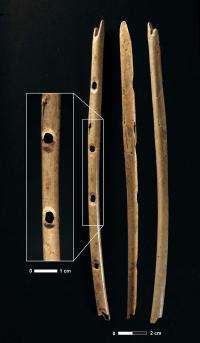Prehistoric flute in Germany is oldest known

Excavations in the summer of 2008 at the sites of Hohle Fels and Vogelherd produced new evidence for Paleolithic music in the form of the remains of one nearly complete bone flute and isolated small fragments of three ivory flutes.
The most significant of these finds, a nearly complete bone flute, was recovered in the basal Aurignacian deposits at Hohle Fels Cave in the Ach Valley, 20 km west of Ulm. The flute was found in 12 pieces. The fragments were distributed over a vertical distance of 3 cm over a horizontal area of about 10 x 20 cm. This flute is by far the most complete of all of the musical instruments thus far recovered from the caves of Swabia.
The preserved portion of the bone flute from Hohle Fels has a length of 21.8 cm and a diameter of about 8 mm. The flute preserves five finger holes. The surfaces of the flute and the structure of the bone are in excellent condition and reveal many details about the manufacture of the flute. The maker carved two deep, V-shaped notches into one end of the instrument, presumably to form the proximal end of the flute into which the musician blew. The find density in this stratum is moderately high with much flint knapping debris, worked bone and ivory, bones of horse, reindeer, mammoth, cave bear, ibex, as well as burnt bone. No diagnostic human bones have been found in deposits of the Swabian Aurignacian, but we assume that modern humans produced the artifacts from the basal Aurignacian deposits shortly after their arrival in the region following a migration up the Danube Corridor.
The maker of the flute carved the instrument from the radius of a griffon vulture (Gyps fulvus). This species has a wingspan between 230 and 265 cm and provides bones ideal for large flutes. Griffon vultures and other vultures are documented in the Upper Paleolithic sediments of the Swabian caves.
The 2008 excavations at Hohle Fels also recovered two small fragments of what are almost certainly two ivory flutes from the basal Aurignacian. The different dimensions of the fragments indicate that the two finds are not from the same instrument. Excavators at Vogelherd in the Lone Valley 25 km northwest of Ulm recovered another isolated fragment of another ivory flute.
The technology for making an ivory flute is much more complicated than making a flute from a bird bone. This process requires forming the rough shape along the long axis of a naturally curved piece of ivory, splitting it open along one of the bedding plains in the ivory, carefully hollowing out the halves, carving the holes, and then rejoining the halves of the flute with an air-tight seal. Given the tendency of delicate ivory artifacts to break into many pieces, it is not unusual to find isolated pieces of such artifacts.
The 10 radiocarbon dates from the basal Aurignacian fall between 31 and 40 ka BP. Available calibrations and independent controls using other methods indicate that the flutes from Hohle Fels predate 35,000 calendar years ago. Apart from the caves of the Swabian Jura there is no convincing evidence for musical instruments predating 30 ka BP.
These finds demonstrate that music played an important role in Aurignacian life in the Ach and Lone valleys of southwestern Germany. Most of these flutes are from archaeological contexts containing an abundance of organic and lithic artifacts, hunted fauna, and burnt bone. This evidence suggests that the inhabitants of the sites played musical instruments in diverse social and cultural contexts and that flutes were discarded with many other forms of occupational debris. In the case of Hohle Fels, the location of the bone flute in a thin archaeological horizon only 70 cm away from a female figurine of similar age suggests that a possible contextual link exists between these two finds.
The flutes from Hohle Fels, Vogelherd and previous finds from nearby Geißenklösterle Cave demonstrate that a musical tradition existed in the cultural repertoire of the Aurignacian around the time modern humans settled in the Upper Danube region. The development of a musical tradition in the Aurignacian accompanied the development of the early figurative art and numerous innovations, including a wide array of new forms of personal ornaments, as well as new lithic and organic technologies. The presence of music in the lives of Upper Paleolithic peoples did not directly produce a more effective subsistence economy and greater reproductive success, but music seems to have contributed to improved social cohesion and new forms of communication, which indirectly contributed to demographic expansion of modern humans relative to the culturally more conservative Neanderthal populations.
The flutes from the caves of the Swabian Jura constitute a key part a major exhibit in Stuttgart entitled Ice Age Art and Culture, which will run from September 18, 2009 - January 10, 2010.
More information: The authors of the paper “New flutes document the earliest musical tradition in southwestern Germany” are Nicholas J. Conard Maria Malina and Susanne C. Münzel. The paper will be published as Advance online publication in Nature, June 25, 2009.
Provided by Universitaet Tuebingen



















